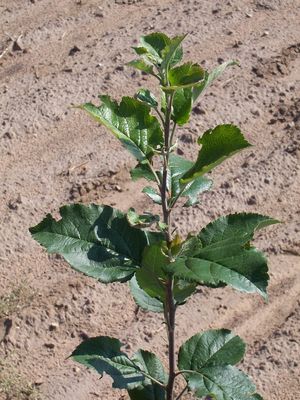
Click the following links for:
Pollination Charts Maturity Charts Chilling Hour Charts Rootstock Charts Hardiness Zone LookupGreat Companions for Malus rootstock 'EMLA 7 clonal rootstock'
« Previous Tree
|
Next Tree »
![]() Print this page
Print this page
Malling 7 Semi-Dwarf Apple Rootstock
Malus rootstock 'EMLA 7 clonal rootstock'
- Summary
- Hardiness Zone & More
EMLA 7 [50-60%] --- This virus-free clone of Malling 7 has proven itself to be one of the most popular rootstocks in the commercial industry, mostly due to its approx. 50-60% of standard size. It tolerates a wide range of soils that are well drained, but does best with adequate moisture thru the summer. Moderately resistant to collar rot. Somewhat susceptible to fire blight, especially on younger trees if the blight enters the root. When tree is older and less vigorous, blight is much less of a worry. Excellent winter hardiness. Only moderately well anchored. Older trees tend to start leaning and tipping unless supported. Fruit size is adequate, but not as large as M 9 or 26. This is an excellent beginners rootstock because of its versatility. It was once a very popular rootstock in Michigan, but many growers are looking for a replacement in the same size range because of its annoying suckering and leaning habits. Very popular and almost all varieties are available on EMLA 7.
The Malling rootstock series often go by slightly different names depending on whether or not they are virus-free selections or not. However, if the word Malling is used in the name, you can be sure that they originated at the East Malling Research Station in England, where researchers developed most of the popular apple rootstocks being used by apple growers today. They still are developing new rootstocks as the commercial industry changes and develops new requirements.
Apples are probably the easiest trees to propagate. Grandpa recommends "chip" budding, which is easy to learn and highly successful. Sincwe cannot ship these early enough in the season, we do not recommend "bench grafting". You usually can start chip budding when your scionwood is mature and buds are developed and readily and easily cut and removed from your scion stick. Usually by August in most areas.
- Zone
- 4-8
- Categories
- On Sale! End of Season,
- Tags


